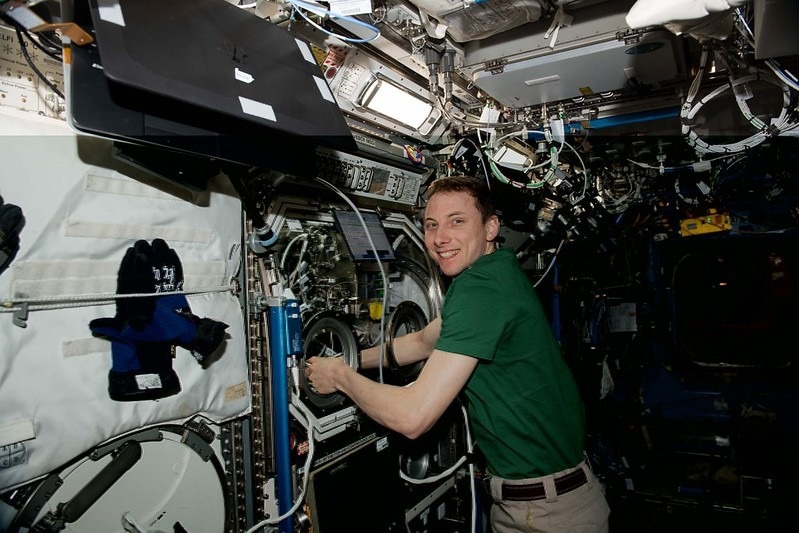Graphene aerogel is a remarkable lightweight material that is both thermally insulating and electrically conductive. This makes it appealing for use in a wide variety of applications—from improved energy storage in batteries to better oil spill cleanup methods to next-generation space suits. A team of researchers from Stanford University and the University of California, Berkeley are leveraging the International Space Station (ISS) National Laboratory to produce higher-quality graphene aerogel than is possible on Earth.
 NASA astronaut Woody Hoburg works on an experiment from Stanford University that aims to synthesize graphene aerogel in space. Image Credit: NASA
NASA astronaut Woody Hoburg works on an experiment from Stanford University that aims to synthesize graphene aerogel in space. Image Credit: NASA
This week, the Crew-6 astronauts onboard the space station completed work on the team’s investigation, which was funded by the U.S. National Science Foundation (NSF). Results could provide new insights into the underlying physics of graphene aerogel synthesis and lead to the development of novel material products.
“Through the microgravity environment of the space station, we can unlock a completely new area of material science that we’ve never had access to,” said Jessica Frick, a research engineer at Stanford.
Frick is part of Stanford’s Extreme Environment Microsystems Laboratory, or XLab. Conceived by Debbie Senesky, an associate professor in aeronautics and astronautics at Stanford, the XLab focuses on making tiny but tough electronics that can work in extreme environments—like space. For their investigation on the space station, Frick and Senesky are collaborating with a research group from UC Berkeley led by Roya Maboudian, a professor of chemical and biomolecular engineering. The team aims to better understand the nature of graphene aerogel and how microgravity affects its properties.
The investigation, which will execute the first step of graphene aerogel synthesis in microgravity, launched on Northrop Grumman’s 19th Commercial Resupply Services mission (NG-19). Results could have implications for future in-space manufacturing as well as deep space missions.
Producing graphene aerogel is a two-step process. The first step is much like making Jell-O. The research team combined graphene oxide flakes in an aqueous solution, like you would combine gelatin powder and hot water for Jell-O. The graphene oxide solution samples were then sent to the space station. Earlier this week, crew members loaded the samples into a furnace, where the solution will be heated to form graphene hydrogel. This process takes a few hours, and once the hydrogel is formed, the astronauts will prepare the samples for return to Earth.
When the samples are back in the lab, the team will do the second step of the process, which involves removing the liquid and leaving behind only air in the form of graphene aerogel. The team will then examine the properties of the aerogel and compare what they find with terrestrially produced graphene aerogel.
The first step of the process is the most crucial, says Frick. On Earth, gravity can pull the graphene flakes down unevenly, which can create cracks in the hydrogel. This could affect the quality of aerogel produced, making it less electrically conductive or have lower absorption rates.
“What we’re expecting to see from the space-produced graphene hydrogel is a depression in the effects of sedimentation that we see here on Earth,” said Senesky. The graphene aerogel produced from the hydrogel will only be a few millimeters in size, but if the team can show that the aerogel is of higher quality than its terrestrial counterparts, production could be scaled up to create larger graphene aerogels.
According to Senesky, aerogels have many remarkable qualities, making them an ideal material for a multitude of applications. They are extremely porous, which makes them good for filtration. For example, NASA used a silica-based aerogel in the agency’s Stardust mission to capture fine dust particles from a comet. Silica aerogels have also been used as insulation on NASA’s Mars rovers and in outerwear clothing here on Earth.
Because graphene is also electrically conductive, researchers are hopeful graphene aerogel can be used for energy storage in batteries and supercapacitors. Additionally, graphene aerogel is a promising thermal insulator that could be used in heat shield technology or embedded in fabrics for aerospace applications. It could also be used as a chemical sensor or even to help absorb certain chemical constituents, which could be beneficial for applications like oil spill cleanup.
“Graphene aerogel is absorbent like a sponge,” said Maboudian. “This means it could be used to soak up materials many more times its own weight, which enables it to be used as a tool to clean up chemical spills and detect harmful chemicals in the environment.”
The NG-19 mission launched from Wallops Flight Facility on August 1 at 8:31 p.m. EDT and included more than 20 ISS National Lab-sponsored payloads. To learn more about all ISS National Lab-sponsored research on this mission, please visit our launch page.